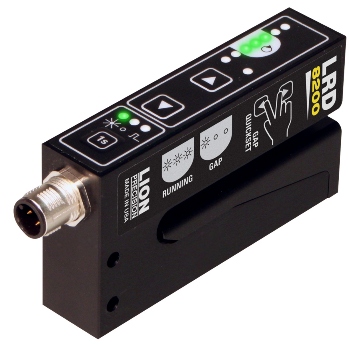The Lion Precision LRD8200 Ultrasonic Clear Label Sensor has a new “Gap Quickset” feature for easier setup. The feature enables the user to place a gap in the sensor and with one click set the sensor’s “Gap” setting. Previously, operators had to use the Up and Down arrows until a display indicated the proper setting.
The function is not the same as a “Teach” function found on some sensors; it simply saves the operator the extra key presses of aligning the setup indicator. A typical teach function involves moving multiple labels through the sensor while an analytical algorithm determines the best settings for the device. According to Mark Kretschmar, Lion Precision communication manager, “A teach function certainly sounds like a good idea, but we regularly hear complaints from users that teach functions don’t always work well. Without manual setup abilities, a poorly functioning teach cycle leaves an operator with an inoperative or unreliable machine and no ability to do anything about it – so we don’t use teach; we leave the operator in control.”
 Lion Precision LRD8200 Ultrasonic Clear Label Sensor.
Lion Precision LRD8200 Ultrasonic Clear Label Sensor.
While not a teach function, the new Gap Quickset does save the operator a little time by automatically adjusting for the gap that is currently in the sensor, saving the user a few button clicks. If the operator thinks the setting can be improved, he or she can just make a small adjustment with a few clicks until satisfied.
In terms of speed and registration accuracy, ultrasonic technology is distinctly inferior to the capacitive technology found in Lion Precision’s other clear label sensors. A detailed study of different label sensor technologies is available at labelsensors.com. The LRD8200 is a response to the packaging industry’s demand for a sensor that works with the largest possible range of materials.
Lion Precision designed the world’s first clear label sensor, the LRD2100 in 1995. The sensor started a small revolution in packaging machinery as the added expense of web eyemarks was no longer required. The new capacitive technology performed equally well on standard paper labels, eliminating the need for traditional optical sensors entirely.